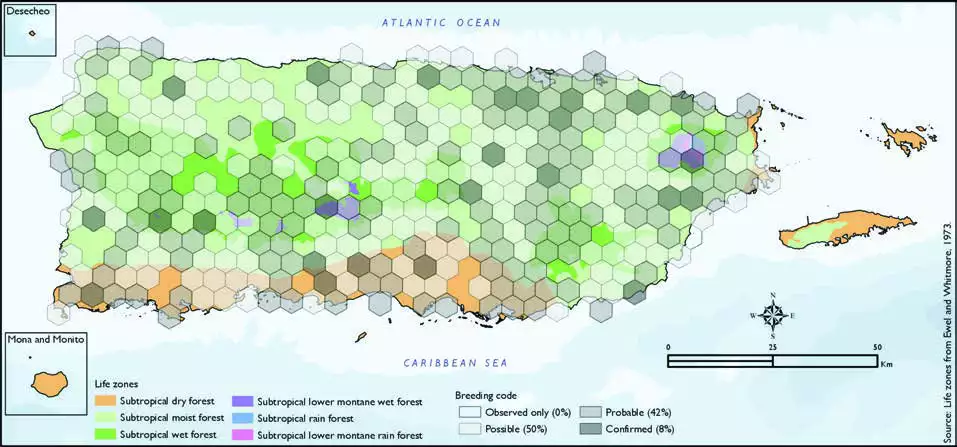Puerto Rican Spindalis
Description
The Puerto Rican spindalis (Spindalis portoricensis) is a bird endemic to the island of Puerto Rico, where it is commonly known as reina mora. The species is widely distributed throughout the island and is an important part of the Puerto Rican ecosystem because of its help in seed dispersal and plant reproduction. The Puerto Rican spindalis is the unofficial national bird[N 1] of Puerto Rico.
The Puerto Rican spindalis exhibits sexual dimorphism with males being brightly colored and females being dully colored. Males are green colored above with an orange neck and chest. They have a black head with two white stripes running across it, with one above and one below the eyes. The tail and wings are gray to black with small white stripes at the tips. In contrast, the female is a dull olive-green color with slightly noticeable white stripes. Sexual dimorphism is also noticeable in weight and size. Females are slightly heavier but smaller in length than males. The male's weight ranges from 22.5 to 37.0 grams with an average of 30.8 grams while the female's ranges from 28.0 to 41.1 grams with an average of 33.5 grams. The length of the male's wings ranges from 82 to 88.5 mm with an average of 85.2 mm while the female's range from 80 to 85.5 mm with an average of 82.6 mm. The length of the male's tail ranges from 59 to 68 mm with an average of 63.3 mm while the female's range from 56 to 65.5 mm with an average of 60.6 mm.
Distribution & Habitat
The Puerto Rican Spindalis is an endemic species restricted to
the main island of Puerto Rico
where it is widespread (Oberle
2018, Raffaele 1989a). This
species inhabits varied habitats,
from forests to gardens and
plantations (Biaggi 1997, Oberle
2018, Raffaele 1989a). The atlas
fieldwork yielded a total of 627
records within 330 hexagons
or 69 percent of the 479 total
hexagons (see map). Of the 330
hexagons where this species
was found, breeding met the
atlas definition of confirmed in
8 percent (25) of the hexagons,
probable in 42 percent (138),
and possible in 50 percent (166), while the species was
observed in an additional
hexagon (<1 percent) but
without evidence of breeding. In
addition, there were no records
of the Puerto Rican Spindalis
in Puerto Ricos outer islands
(see map). Puerto Rican Spindalis distribution. The map shows the highest breeding code by hexagon and overlaying the ecological life zones
in Puerto Rico. Note: percentages may not total 100 due to rounding.

Breeding Habits
The Puerto Rican Spindalis is an abundant bird that breeds
from January to June, according
to previously published reports
(Biaggi 1997). The nest consists
of a loose cup of vegetation
and is usually built low in a
bush, tree, or palm (Raffaele
and others 1998). Atlas results
indicate an increase in breeding 261Puerto Rican Spindalis/Reinamoraactivity from March to June, and most breeding occurs in
the subtropical moist forest life
zone (see chart). Results show
that this species breeds in all
subtropical forest life zones
(see table and map). It was
recorded in the subtropical moist
forest life zone (61 percent of
the hexagons), subtropical wet
and lower montane wet forest
life zones (22 percent of the
hexagons), and subtropical
dry forest life zone (16 percent
of the hexagons). There was one observation (classified as
probable breeding) located in
the subtropical rain and lower
montane rain forest life zones.
Conservation
The Puerto Rican Spindalis population is believed to be
stable, and it is listed as a species
of least concern by the IUCN
(BirdLife International 2016). In
2005, this species was locally
listed as Data Deficient, but a
2015 assessment classified it as Low Risk (PRDNER 2015).
Locally, this species is not
listed in any of the threatened
categories of PRDNER and
USFWS. In Puerto Rico, the
Puerto Rican Spindalis has
a protected habitat in land
of 11 percent or 898 km2 of the total area covered by the
hexagons where evidence of
breeding was found for this
species (7869 km2).
Related Species
Family:
tanager